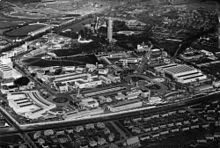Empire Exhibition, Scotland


Empire Exhibition, Scotland 1938 (unofficially known as the British Empire Exhibition, Glasgow) was an international exposition held at Bellahouston Park in Glasgow, from May to December 1938.
The Exhibition marked fifty years since Glasgow's first great exhibition, the International Exhibition (1888) held at Kelvingrove Park. It also offered a chance to boost the economy of Scotland, recovering from the depression of the 1930s.
It was the second British Empire Exhibition, the first having been held at Wembley Park in 1924-25.
The event

Despite 1938 being one of the wettest summers on record, the Exhibition attracted 12 million visitors.
An international football competition, the Empire Exhibition Trophy, was held in conjunction with the Exhibition.
Exhibition pavilions were erected on the site, the two largest being the Palace of Engineering and Palace of Industry, and countries in the British Empire contributed their own national pavilions. The Exhibition was masterplanned by Thomas S. Tait, who headed of a team of nine architects, which included Basil Spence and Jack Coia.
The most prominent structure was the Tait Tower (officially the Tower of Empire) 470 feet (140 m) high. Although it was intended to remain as a permanent monument after the exhibition, the tower was demolished in July 1939.
Legacy
The only major surviving original structure on the site is the Palace of Art.
The former South Africa pavilion with its distinctive curvilinear Dutch Baroque gables also survives. Built as a temporary structure, the building was later moved to Ardeer to become a staff canteen within ICI Ardeer.[1]
The Palace of Engineering was dismantled in 1940, transported to Scottish Aviation at Prestwick and re-erected, dramatically increasing the company's factory floor space. The building is still used by aviation industry today and is a distinctive feature at Prestwick Airport.[2]
In December 2007, Digital Design Studio at Glasgow School of Art created a 3D graphic reconstruction of the 1938 exhibition, sourced from contemporary photographs, film footage, sketches and drawings from the archive of the Mitchell Library, amongst other sources.[3][4] In 2010, the Digital Design Studio was awarded a further research grant to enhance the 3D model for public engagement.[5] The Glasgow School of Art's YouTube channel contains several videos of the 3D model.[6]
See also
- International Exhibition of Science, Art and Industry (1888)
- Glasgow International Exhibition (1901)
- Scottish Exhibition of National History, Art and Industry (1911)
- Glasgow Garden Festival (1988)
Further reading
- Perilla Kinchin and Juliet Kinchin - Glasgow's Great Exhibitions: 1888, 1901, 1911, 1938, 1988 ISBN 0-9513124-0-5
- Johnston, Ian (2008). Edit. Glasgow's Greatest Exhibition. Recreating the 1938 Empire Exhibition. Edinburgh : RIAS. ISBN 978-1-873190-59-3.
External links
- Empire Exhibition, Scotland 1938 - 3D reconstruction of the exhibition by the Digital Design Studio at Glasgow School of Art
- Bellahouston Park
- Empire Exhibition, Glasgow 1938: visual library
- Glasgow's great exhibitions
- Bellahouston Park History & Heritage - Glasgow City Council (includes Empire Exhibition history)
- National Library of Scotland: SCOTTISH SCREEN ARCHIVE (selection of archive films about the Empire Exhibition in Glasgow, 1938)
References
- ^ http://data.historic-scotland.gov.uk/pls/htmldb/f?p=2200:15:0::::BUILDING:19136
- ^ http://www.glasgowprestwick.com/about-the-airport/corporate-information/airport-history.html
- ^ Greenshields, Karen. "Empire Exhibition Strikes Back". STV News. Scottish Television. Retrieved 2008-11-16.
- ^ McKinnon, Ross (2007-05-23). "THE EMPIRE STRIKES BACK: Second city of Exhibition is reborn for 21st century". Evening Times (Glasgow). Retrieved 2008-11-16.
- ^ http://www.gsa.ac.uk/researchandpostgraduate/content/default.asp?page=s18_3_12
- ^ https://www.youtube.com/user/GlasgowSchoolofArt?feature=chclk#p/a/u/1/ONdp4HcXiNg
